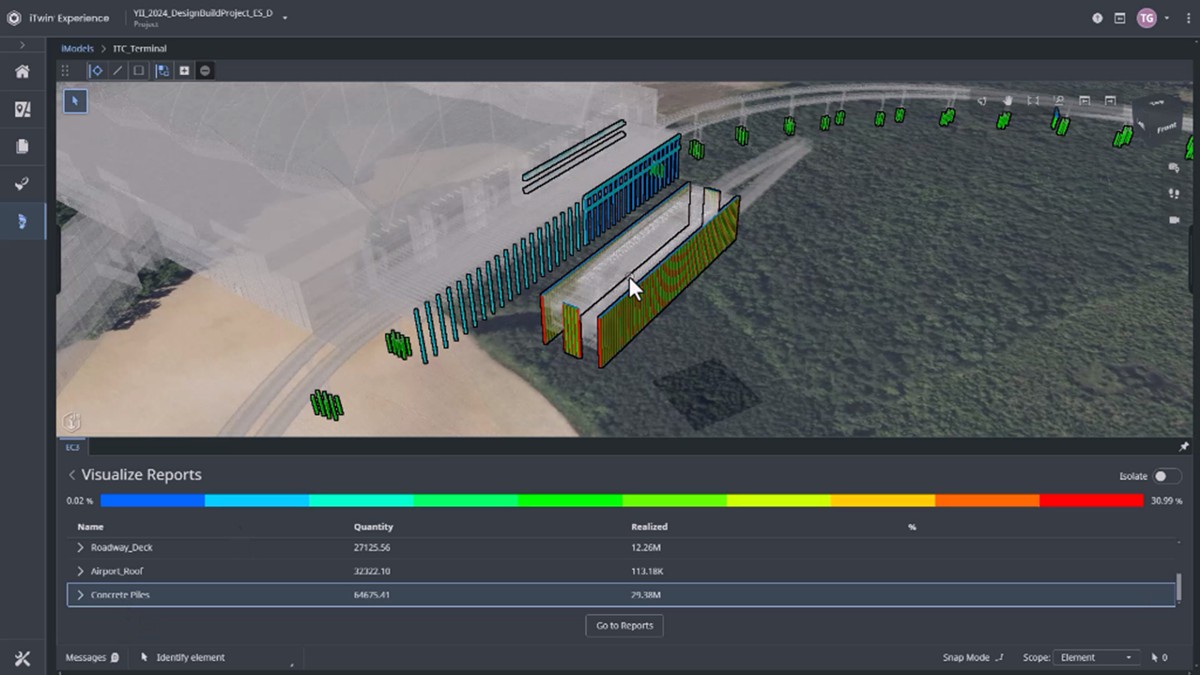New Carbon Analysis Tools to Revolutionise Infrastructure Design
The construction industry’s focus on sustainability is intensifying, and with good reason. Infrastructure development accounts for a significant chunk of the world’s carbon emissions, especially during the build phase.
Addressing this concern head-on, Bentley Systems has launched new Carbon Analysis capabilities that are set to transform how construction professionals approach carbon impact during the design process. By simplifying carbon assessment and integrating sustainability directly into infrastructure design workflows, Bentley’s innovative tools are helping to cut emissions before infrastructure projects even break ground.
Understanding the Impact of Embodied Carbon
Before diving into Bentley’s ground-breaking updates, it’s crucial to understand the concept of embodied carbon. Unlike operational carbon, which refers to emissions during a building’s lifespan, embodied carbon encompasses the greenhouse gases emitted throughout the construction phase—from raw material extraction to manufacturing and assembly. In other words, it’s the carbon footprint accumulated before an asset is even used.
The significance of embodied carbon cannot be understated. According to Savina Carluccio, Executive Director of the International Coalition for Sustainable Infrastructure (ICSI): “Between now and 2050, embodied carbon linked to new infrastructure is projected to be responsible for half of the world’s carbon footprint released—even before the infrastructure is used.” Given this significant contribution, Carluccio stresses the importance of the construction sector acting with urgency to curb embodied carbon. Digital tools, collaborative value chains, and the use of carbon-efficient materials must be leveraged to realise meaningful decarbonisation.

Introducing Bentley’s Carbon Analysis Capabilities
Bentley Systems, a key player in infrastructure engineering software, has taken a substantial step in advancing sustainable infrastructure. The company recently unveiled new Carbon Analysis capabilities within its iTwin Experience platform. These features aim to simplify the assessment and reduction of carbon footprints during the design stage, making carbon impact evaluation an intuitive part of the engineering process.
Using Bentley’s new tools, infrastructure professionals can now visualise embodied carbon with unprecedented ease. The integration allows users to connect their design data directly to a carbon assessment calculator, providing real-time insights into the environmental impact of different design choices. This functionality, in turn, empowers teams to adapt and explore sustainable alternatives more effectively.
Chris Bradshaw, Chief Sustainability Officer at Bentley Systems, remarks: “Carbon assessments should be standard practice for global infrastructure projects, but creating carbon reports isn’t easy. Using Bentley’s new Carbon Analysis capabilities helps transform the tedious task of carbon reporting into a smooth, automated process—providing infrastructure professionals with greater visibility into carbon impacts and helping them design sustainable infrastructure faster and more easily.”
Tackling Challenges in Carbon Reporting
Traditionally, generating a carbon analysis report is no small feat. It requires collating siloed data, translating that data into meaningful carbon metrics, and finally compiling a comprehensive report—a process that is both time-consuming and costly. For large infrastructure projects, the process can be even more daunting due to the complex web of stakeholders, diverse datasets, and multiple material types involved.
Bentley’s new solution aims to simplify this complicated landscape, tackling three core issues:
- Automated Material Quantification: The tools can automatically aggregate data from different sources into a single digital twin, providing a comprehensive view. With integrated workflows, Bentley’s platform can even fill in the blanks, calculating material quantities that might be missing from initial design files. This eliminates the guesswork and reduces reliance on outdated spreadsheets.
- Streamlined Reporting: By linking the design data with a carbon assessment calculator, professionals can now generate an accurate cradle-to-gate carbon accounting report in just a few clicks. The automation of data collection means less manual work and more time to focus on improving the actual designs.
- 3D Visualisation: What sets Bentley’s tools apart is the use of cloud-based heat maps within a live 3D digital twin model. These visualisations provide clear, easy-to-understand feedback on the embodied carbon of different design elements, allowing professionals to quickly identify areas for improvement.
WSP’s Experience with Bentley’s Carbon Tools
These advanced capabilities aren’t just theoretical; industry professionals have already started reaping the benefits. WSP, a leader in sustainability consulting, was part of an early access programme for Bentley’s new Carbon Analysis tools. Their experience highlights the transformative power of these innovations.
Kelvin Saldanha, Associate Director at WSP, shares: “In the past, there have been significant challenges when creating a carbon report for a proposed design. For example, the wide range of methodologies used to calculate embodied carbon made the process feel opaque. In addition, the process was time-consuming, as it required translating every detail into a full carbon evaluation. With Bentley’s new Carbon Analysis capabilities, our design team has better transparency to calculate, analyse, and report meaningful carbon footprint impacts within any design change—in real-time with the click of a button, which has greatly reduced feedback loops from months or weeks to days.”
The ability to integrate carbon analysis directly into the design process has allowed WSP to make informed decisions quickly, reducing project timelines and ensuring a more sustainable approach to infrastructure development. This real-world application is precisely what Bentley envisioned—enabling professionals to cut through complexity and focus on what matters: building a sustainable future.

Seamless Integration for Infrastructure Professionals
One of the standout aspects of Bentley’s new capabilities is how seamlessly they integrate with existing tools. Infrastructure professionals working with Bentley’s iTwin Experience can use their own preferred carbon assessment calculators, like EC3 or OneClickLCA, to gain insights into the embodied carbon of their projects. These tools work in tandem to create a more complete understanding of the environmental impact of design choices.
The added bonus? All these features come at no additional cost to current iTwin Experience users. However, it’s worth noting that a separate licence is required for the chosen carbon assessment calculator, which users must obtain directly from the vendors.
Making Sustainability the Norm, Not the Exception
As the pressure mounts to address climate change, companies like Bentley are leading the charge to make sustainability more accessible. The infrastructure sector has long faced challenges in assessing carbon impacts, often leaving these considerations to later stages or failing to account for them altogether. Bentley’s new tools change that dynamic by putting sustainability at the forefront, giving designers the power to understand the carbon implications of their decisions early on.
The ability to visualise embodied carbon in real-time and adjust accordingly provides a significant advantage in the quest for more sustainable infrastructure. Instead of treating carbon analysis as a cumbersome task to be tackled at the end, it becomes an integrated part of the workflow, encouraging more thoughtful design choices from the get-go.
Bentley Systems’ move is not just about technology; it’s about reshaping how the industry thinks about and values sustainability. By making carbon impact analysis a natural part of the design phase, Bentley is helping professionals consider the bigger picture and contribute meaningfully to reducing emissions globally.
Future Potential of Carbon Analysis in Infrastructure
With this innovation, Bentley Systems isn’t just keeping up with the industry’s growing focus on sustainability—they’re setting the pace. As more infrastructure companies adopt carbon assessment tools, we could see significant changes in the construction landscape, with increased efficiency, fewer manual processes, and a stronger emphasis on responsible development.
Imagine a future where every infrastructure project comes with a detailed carbon report that’s easily accessible, where sustainable design decisions are made collaboratively, and where design software assists teams in exploring carbon-efficient materials effortlessly. Bentley’s new Carbon Analysis capabilities represent a step towards that future, providing not just the tools but the vision required for meaningful change.
A Step Towards Greener Infrastructure
Bentley Systems’ new Carbon Analysis capabilities in the iTwin Experience platform offer a glimpse into the future of infrastructure design—one where sustainability is embedded into every decision, and assessing carbon footprints becomes second nature for professionals. By simplifying reporting, automating material quantification, and making it easier to visualise impacts, Bentley has taken significant steps towards reducing embodied carbon in the construction industry.
It’s up to the sector to make the most of these advancements, and the future looks promising. Tools like these enable us to build not only with efficiency and aesthetics in mind but also with the planet in mind—a true reflection of responsible, modern engineering.




















